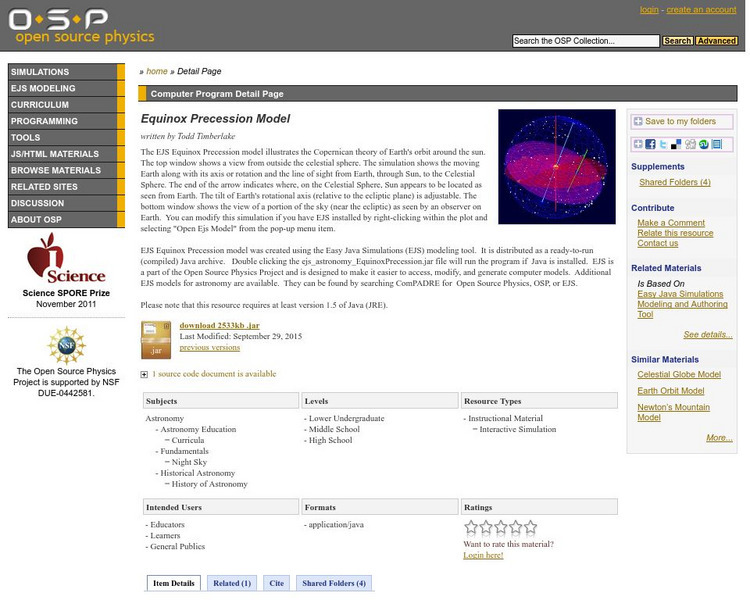Concord Consortium
Concord Consortium: Stem Resources: Changes in the Environment
An activity to help students understand that as the environment changes, plants and animals must evolve to stay alive. Students watch as a mystery plants grow in a changing environment to see if they will evolve or go extinct.
Concord Consortium
Concord Consortium: Stem Resources: Molecular Self Assembly
A series of science simulations exploring how molecules assemble themselves and how scientists are learning to engineer their structure. Students will discover what patterns molecules form with interactive lessons. At the end there is a...
Concord Consortium
Concord Consortium: Stem Resources: Diffusion, Osmosis, and Active Transport
Have you ever wondered how important gases enter and leave cells? Take an up close tour of a pore in a cell membrane. Then explore diffusion, osmosis, and active transport through this collection of interactive models.
Concord Consortium
Concord Consortium: Stem Resources: Natural Selection
Build a dam in the middle of an ecosystem and observe how the population of plants and animals adapt to their new environment with this science simulation. Learn how the populations adapt to survive in their new habitat. Then remove the...
Carnegie Mellon University
Chem Collective: Osmotic Pressure
When a balloon is filled to near bursting with SF6 is left in air, it will often burst after a period of time. This is because the smaller N2 molecules diffuses into the balloon while the larger SF6 molecules remains causing the balloon...
Carnegie Mellon University
Chem Collective: Brownian Motion
Particulate level simulations that show only solute particles are convenient, since they focus student attention on the molecules of most interest. However, such solute molecules move in a Brownian manner. This simulation helps students...
Carnegie Mellon University
Chem Collective: Chemical Potential: Staircase Demonstration
As we look for connection points across disciplines, we are increasingly drawn to chemical potential as the connection point. This simulation shows particles thermally distributed on a staircase. A linear increase in energy leads to an...
Carnegie Mellon University
Chem Collective: Dna Binding Dyes Scenario
This activity explores the equilibrium of dyes that self-assemble into DNA templates. Students use knowledge of equilibrium and quantitative spectroscopy to explore different dyes that bind selectively to DNA molecules. In this activity,...
University of Colorado
University of Colorado: Ph Et Interactive Simulations: The Ramp
Which object takes more energy to push up a ramp: a file cabinet, a refrigerator, a piano, or a sleepy dog? Find out in this ramp simulation when you change the angle of the incline, change the objects, or change the friction on the ramp.
University of Colorado
University of Colorado: Ph Et Interactive Simulations: Lasers
Learn about absorption and emission by creating a laser. Pump the chamber with a photon beam, and manipulate the energy states of the laser's atoms to control its output.
University of Colorado
University of Colorado: Ph Et Interactive Simulations: Masses & Springs
Hang various mass weights on spring scales while you adjust the spring stiffness and damping in this online activity. Slow down the action, take it to another planet, or watch the amount of potential, thermal, and kinetic energy.
University of Colorado
University of Colorado: Ph Et Interactive Simulations: Interactive Simulations: Electric Field Hockey
Play hockey with electric charges in this interactive electric hockey simulation. Place charges on the ice, then hit start to try to get the puck in the goal. As the game is being played, view the electric field, and trace the puck's...
The Association of the British Pharmaceutical Industry
Association of the British Pharmaceutical Industry: Solids, Liquids, and Gasses
A collection of cartoon animations that teach students what they need to understand about solids, liquids, and gases.
American Association of Physics Teachers
Com Padre Digital Library: Open Source Physics: Equatorial Coordinates Model
Using equatorial coordinates, observers will examine the position of a star over the course of the night sky in this simulation.
American Association of Physics Teachers
Com Padre Digital Library: Open Source Physics: Solar and Lunar Eclipse Model
Experience the simulation of both solar and lunar eclipses to understand why these eclipses do not occur monthly.
American Association of Physics Teachers
Com Padre Digital Library: Open Source Physics: Newton's Mountain Model
A science simulation launches a projectile from the top of a mountain testing Newton's theory introduced in Principia.
American Association of Physics Teachers
Com Padre Digital Library: Open Source Physics: Earth Orbit Model
Nicolaus Copernicus developed the theory of Earth's orbit around the sun demonstrated in this science simulation.
American Association of Physics Teachers
Com Padre Digital Library: Open Source Physics: Equinox Precession Model
Experience a science simulation illustrating the Copernican theory of Earth's orbit around the sun.
American Association of Physics Teachers
Com Padre Digital Library: Open Source Physics: Copernican System Model
The Copernican system of planetary motion is clarified in this simulation.
American Association of Physics Teachers
Com Padre Digital Library: Open Source Physics: Circular Well Model
This downloadable java simulation models the 2D energy eigenstates of a particle trapped in a very deep two-dimensional circular well.
American Association of Physics Teachers
Com Padre Digital Library: Open Source Physics: Superior Ptolemaic Model
A simulation illustrating Ptolemy's geometrical system of explaining the varying speeds and directions of the planets, sun, and moon.
American Association of Physics Teachers
Com Padre Digital Library: Open Source Physics: Inferior Ptolemaic Model
This simulation offers an illustration of Ptolemy's orbit for an inferior planet.
American Association of Physics Teachers
Com Padre Digital Library: Open Source Physics: Celestial Globe Model
Users have the opportunity to adjust several variables in this simulation demonstrating the Ancient Greek's Two Sphere Universe theory.
American Association of Physics Teachers
Com Padre Digital Library: Open Source Physics: Electric Field: What Is Wrong?
What's wrong with this model? Students expect simulations to show factual science concepts, but these particular simulations are intentionally built incorrectly. The objective is to find where the physics concerning electric fields is...

























